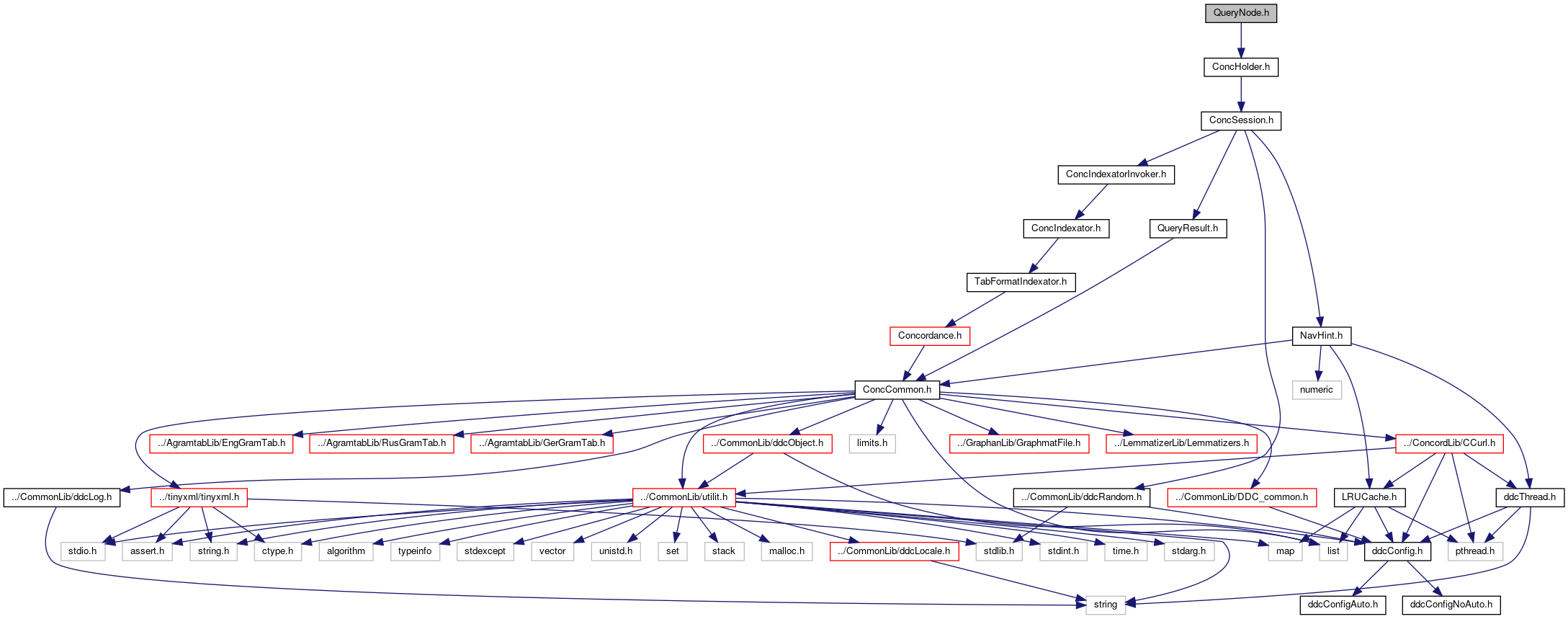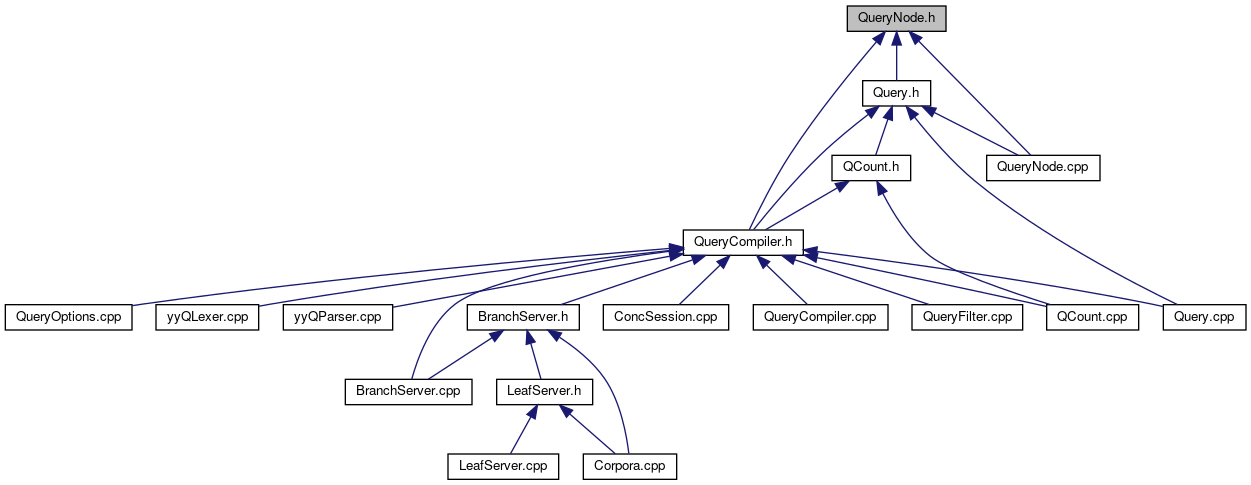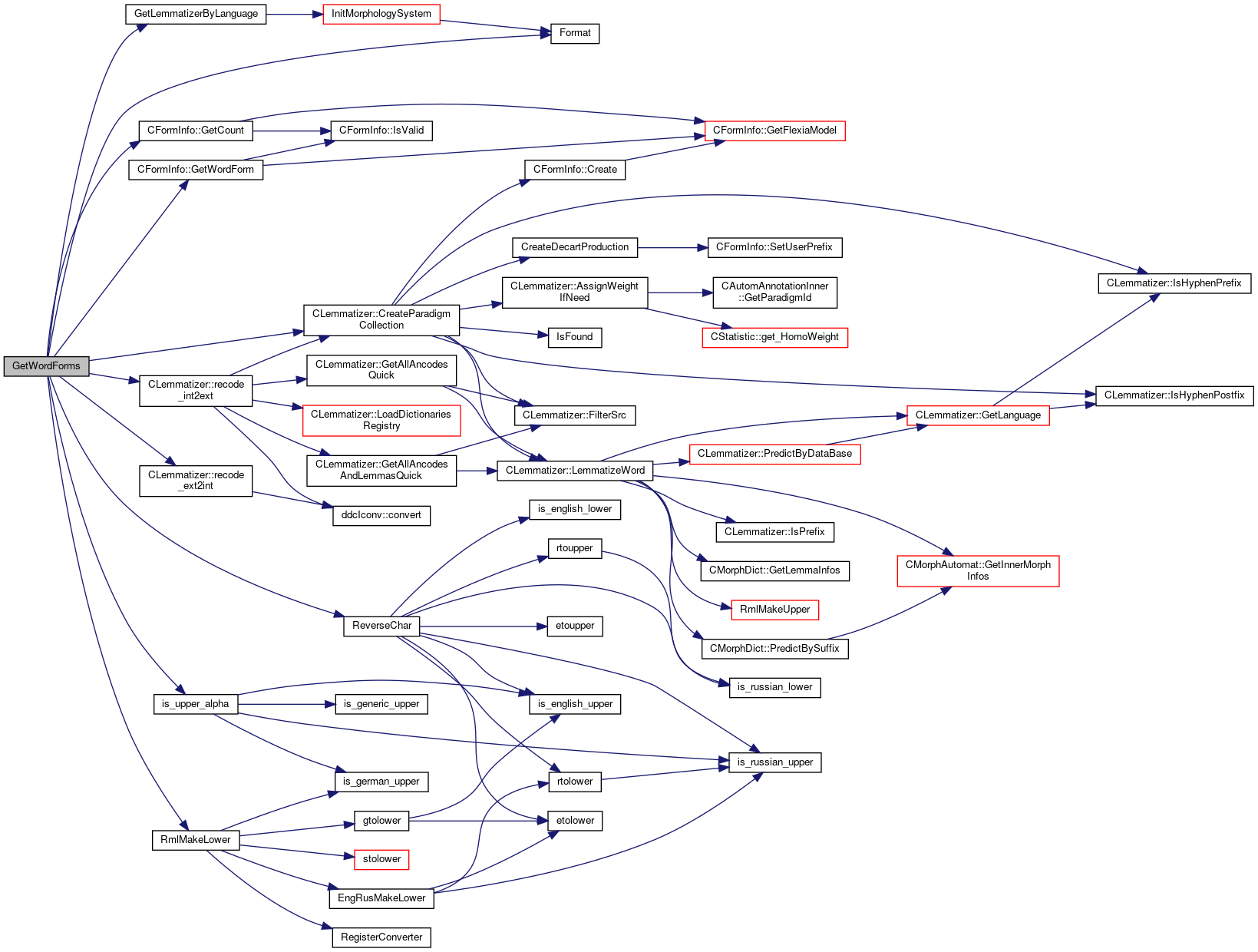#include "ConcHolder.h"

Go to the source code of this file.
Classes | |
| class | CQueryNode |
| CQueryNode is an abstract class for any node in a query parse tree. A parse tree is built by YACC during CQueryCompiler::ParseQuery. This class contains all members which are common to atomic and operation nodes. More... | |
| class | CQueryBinaryOperationNode |
| class | CQueryAndOperation |
| CQueryAndOperation implements the hit intersection or "and" operator: for example, "Mother&&father". More... | |
| class | CQueryOrOperation |
| CQueryOrOperation implements the hit union or "or" operator: for example, "Mother||father". More... | |
| class | CQueryTokenNode |
| CQueryTokenNode is a class which corresponds to one token or it's singular property (for example lemma) More... | |
| class | CQuerySequenceNode |
| CQuerySequenceNode is an implementation of sequence operator, for example, "Mother and father". This class holds a sequence of nodes of type CQueryTokenNode (slot m_Items). Between m_Items[i] and m_Items[i+1] must be no more than m_Distances[i] tokens. More... | |
| class | CQueryNearNode |
| CQueryNearNode is a class which is used to search two or three child nodes, which are inside some text period of length CQueryNearNode::m_Distance , i.e. an implementation of "near" operator NEAR(a,b,2) and NEAR(a,b,c, 2). Note that for the 3-subquery form NEAR(a,b,c, n), n specifies the maximum number of tokens between ANY PAIR of subqueries (a,b), (b,c), or (a,c). More... | |
| class | CQueryWithNode |
| CQueryWithNode is a class which is used to search a node which simultaneously has two properties, namely m_pChild1 and m_pChild2. (implementation of "with" operator: for example, Mother with [NOUN] ) More... | |
| class | CQueryWithoutNode |
| CQueryWithoutNode: (EXPR1 without EXPR2) behaves like (EXPR1 WITH !EXPR2) More... | |
| class | CQueryWithorNode |
| CQueryWithorNode: (EXPR1 withor EXPR2) behaves like (EXPR1 || EXPR2) under token-identity. More... | |
| struct | CQOccurrenceIterator |
| CQOccurrenceIterator (formerly CQNearEvalItem) is used to iterate over query occurrences; used by near() queries. More... | |
| struct | CQTokenOccurrenceIterator |
| CQTokenOccurrenceIterator (formerly CQNearEvalItem) is used to iterate over query occurrences;. More... | |
Macros | |
| #define | DDC_OCCITER_LB_COEF 4 |
Functions | |
| void | GetWordForms (const MorphLanguageEnum Langua, const string &src, set< string > &WordForms) |
Variables | |
| const size_t | MaxDistanceForNear |
Macro Definition Documentation
◆ DDC_OCCITER_LB_COEF
| #define DDC_OCCITER_LB_COEF 4 |
DDC_OCCITER_LB_COEF
- minimum coefficient for deciding between linear increment and std::lower_bound() on CQTokenOccurrenceIterator::seek()
heuristic for approximating number of linear-search ops per binary-search visitation (empirically set to 4)
- speeds up phrase-, WITH-, and WITHOUT-queries by up to 69%, e.g. ("@das @Haus")
- can hurt up to 5% for "very simple" &&-queries, e.g. ( && )
- introduced in v2.1.19-pre1
Referenced by CQTokenOccurrenceIterator::seek().
Function Documentation
◆ GetWordForms()
| void GetWordForms | ( | const MorphLanguageEnum | Langua, |
| const string & | src, | ||
| set< string > & | WordForms | ||
| ) |
compute the set of types WordForms which may share a lemma with src in language Langua.
The underlying CLemmatizer should handle transcoding of user queries transparently, assuming you called CLemmatizer::initIconv() with the appropriate encoding arguments.
This is very ugly, and the entire morphology system needs an overhaul.
Formerly a hidden function in QueryNode.cpp.
References CLemmatizer::CreateParadigmCollection(), errProcessMorphology, Format(), CFormInfo::GetCount(), GetLemmatizerByLanguage(), CFormInfo::GetWordForm(), is_upper_alpha(), morphUnknown, CLemmatizer::recode_ext2int(), CLemmatizer::recode_int2ext(), ReverseChar(), and RmlMakeLower().
Referenced by CQTokenOccurrenceIterator::operator==().


Variable Documentation
◆ MaxDistanceForNear
| const size_t MaxDistanceForNear |
 1.8.13
1.8.13